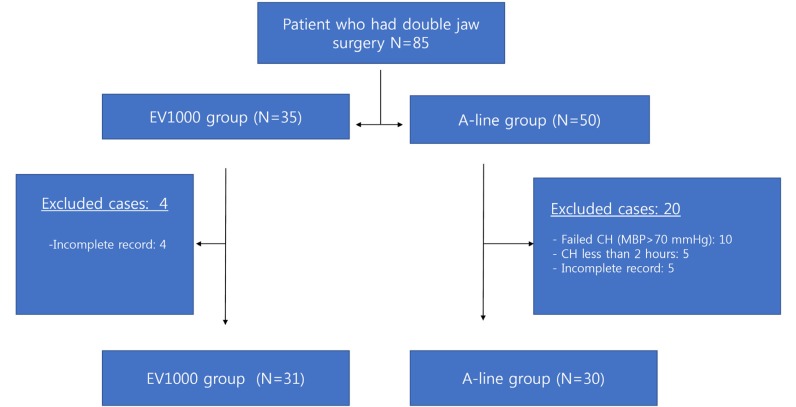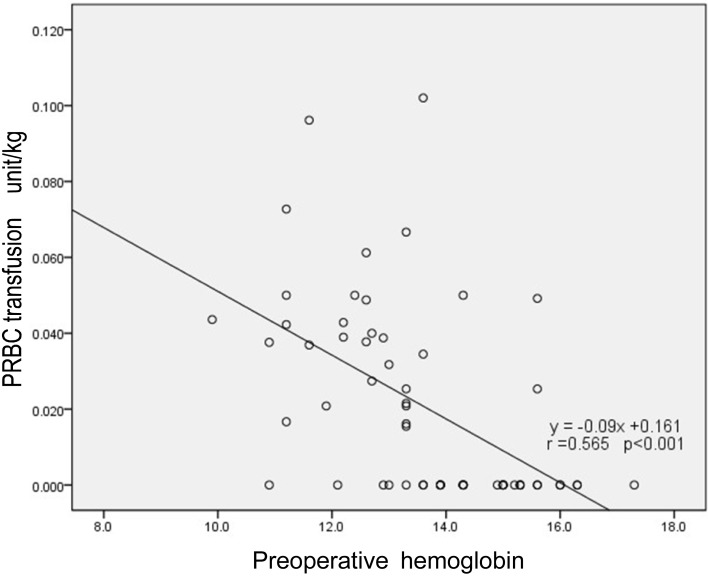J Dent Anesth Pain Med.
2019 Dec;19(6):353-360. 10.17245/jdapm.2019.19.6.353.
Efficacy of minimal invasive cardiac output and ScVOâ‚‚ monitoring during controlled hypotension for double-jaw surgery
- Affiliations
-
- 1Department of Anesthesiology and Pain Medicine, College of Medicine, Dankook University, Cheonan, Korea. drjack@nate.com
- KMID: 2466650
- DOI: http://doi.org/10.17245/jdapm.2019.19.6.353
Abstract
- BACKGROUND
Controlled hypotension (CH) provides a better surgical environment and reduces operative time. However, there are some risks related to organ hypoperfusion. The EV1000/FloTrac system can provide continuous cardiac output monitoring without the insertion of pulmonary arterial catheter. The present study investigated the efficacy of this device in double jaw surgery under CH.
METHODS
We retrospectively reviewed the medical records of patients who underwent double jaw surgery between 2010 and 2015. Patients were administered conventional general anesthesia with desflurane; CH was performed with remifentanil infusion and monitored with an invasive radial arterial pressure monitor or the EV1000/FloTrac system. We allocated the patients into two groups, namely an A-line group and an EV1000 group, according to the monitoring methods used, and the study variables were compared.
RESULTS
Eighty-five patients were reviewed. The A-line group reported a higher number of failed CH (P = 0.005). A significant correlation was found between preoperative hemoglobin and intraoperative packed red blood cell transfusion (r = 0.525; P < 0.001). In the EV1000 group, the mean arterial pressure (MAP) was significantly lower 2 h after CH (P = 0.014), and the cardiac index significantly decreased 1 h after CH (P = 0.001) and 2 h after CH (P = 0.007). Moreover, venous oxygen saturation (ScVO2) decreased significantly at both 1 h (P = 0.002) and 2 h after CH (P = 0.029); however, these values were within normal limits.
CONCLUSION
The EV1000 group reported a lower failure rate of CH than the A-line group. However, EV1000/FloTrac monitoring did not present with any specific advantage over the conventional arterial line monitoring when CH was performed with the same protocol and same mean blood pressure. Preoperative anemia treatment will be helpful to decrease intraoperative transfusion. Furthermore, ScVO2 monitoring did not present with sufficient benefits over the risk and cost.
MeSH Terms
Figure
Reference
-
1. Varol A, Basa S, Ozturk S. The role of controlled hypotension upon transfusion requirement during maxillary downfracture in double-jaw surgery. J Craniomaxillofac Surg. 2010; 38:345–349. PMID: 19913434.
Article2. Jangra K, Malhotra SK, Gupta A, Arora S. Comparison of quality of the surgical field after controlled hypotension using esmolol and magnesium sulfate during endoscopic sinus surgery. J Anaesthesiol Clin Pharmacol. 2016; 32:325–328. PMID: 27625479.
Article3. Dolman RM, Bentley KC, Head TW, English M. The effect of hypotensive anesthesia on blood loss and operative time during Le Fort I osteotomies. J Oral Maxillofac Surg. 2000; 58:834–839. discussion 40. PMID: 10935580.
Article4. Ettinger KS, Yildirim Y, Weingarten TN, Van Ess JM, Viozzi CF, Arce K. Hypotensive Anesthesia Is Associated With Shortened Length of Hospital Stay Following Orthognathic Surgery. J Oral Maxillofac Surg. 2016; 74:130–138. PMID: 26047710.
Article5. Carlos E, Monnazzi MS, Castiglia YM, Gabrielli MF, Passeri LA, Guimaraes NC. Orthognathic surgery with or without induced hypotension. Int J Oral Maxillofac Surg. 2014; 43:577–580. PMID: 24331734.
Article6. Park SY, Seo KS, Karm MH. Perioperative red blood cell transfusion in orofacial surgery. J Dent Anesth Pain Med. 2017; 17:163–181. PMID: 29090247.
Article7. Ervens J, Marks C, Hechler M, Plath T, Hansen D, Hoffmeister B. Effect of induced hypotensive anaesthesia vs isovolaemic haemodilution on blood loss and transfusion requirements in orthognathic surgery: a prospective, single-blinded, randomized, controlled clinical study. Int J Oral Maxillofac Surg. 2010; 39:1168–1174. PMID: 20961738.
Article8. Gillespie R, Shishani Y, Streit J, Wanner JP, McCrum C, Syed T. The safety of controlled hypotension for shoulder arthroscopy in the beach-chair position. J Bone Joint Surg Am. 2012; 94:1284–1290. PMID: 22810398.
Article9. Shear T, Tobias JD. Cerebral oxygenation monitoring using near infrared spectroscopy during controlled hypotension. Paediatr Anaesth. 2005; 15:504–508. PMID: 15910352.
Article10. Yazigi A, Madi-Jebara S, Haddad F, Hayek G, Jawish D. Accuracy of radial arterial pressure measurement during surgery under controlled hypotension. Acta Anaesthesiol Scand. 2002; 46:173–175. PMID: 11942865.
Article11. Tobias JD. Nicardipine for controlled hypotension during orthognathic surgery. Plast Reconstr Surg. 1997; 99:1539–1543. PMID: 9145121.
Article12. Maeda T, Hamaguchi E, Kubo N, Shimokawa A, Kanazawa H, Ohnishi Y. The accuracy and trending ability of cardiac index measured by the fourth-generation FloTrac/Vigileo system and the Fick method in cardiac surgery patients. J Clin Monit Comput. 2019; 33:767–776. PMID: 30406422.
Article13. Pope JV, Jones AE, Gaieski DF, Arnold RC, Trzeciak S, Shapiro NI. Multicenter study of central venous oxygen saturation (ScvO(2)) as a predictor of mortality in patients with sepsis. Ann Emerg Med. 2010; 55:40–46.e1. PMID: 19854541.
Article14. Myatra SN, Prabu NR, Divatia JV, Monnet X, Kulkarni AP, Teboul JL. The changes in pulse pressure variation or stroke volume variation after a “tidal volume challenge” reliably predict fluid responsiveness during low tidal volume ventilation. Crit Care Med. 2017; 45:415–421. PMID: 27922879.
Article15. Hartog C, Bloos F. Venous oxygen saturation. Best Pract Res Clin Anaesthesiol. 2014; 28:419–428. PMID: 25480771.
Article16. Shin HJ, Na HS, Koh WU, Ro YJ, Lee JM, Choi YJ. Complications in internal jugular vs subclavian ultrasound-guided central venous catheterization: a comparative randomized trial. Intensive Care Med. 2019; 45:968–976. PMID: 31143996.
Article17. Koo BN, Kwon MA, Kim SH, Kim JY, Moon YJ, Park SY. Korean clinical practice guideline for perioperative red blood cell transfusion from Korean Society of Anesthesiologists. Korean J Anesthesiol. 2019; 72:91–118. PMID: 30513567.
- Full Text Links
- Actions
-
Cited
- CITED
-
- Close
- Share
- Similar articles
-
- Effects of Hydralazine Pretreatment on Esmolol-induced Controlled Hypotension during Spine Surgery
- Cardiac Output Measurement
- Minimally Invasive Cardiac Surgery
- The Effect of Nitroglycerine-Induced Hypotension on the Hemodynamics During Isoflurane-N2O-O2 Anesthesia in Dogs
- Induced Hypotension Using Esmolol in Spinal Surgery



